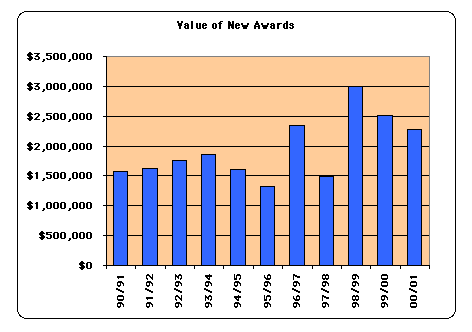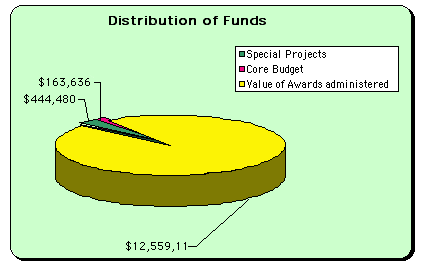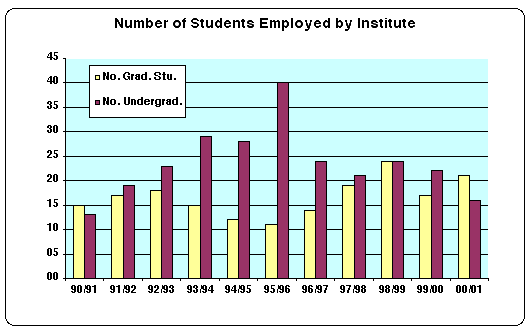Director's Statement
The paradigm of plate tectonics yielded a quantum leap forward in understanding of how the Earth works. Nonetheless, several decades after the plate tectonic "revolution" began, fundamental problems remain in developing a dynamical theory of Earth deformation, in creating a mechanistic understanding of the processes that shape the Earth’s surface, and in quantifying the complexity of interactions among crustal deformation, mantle dynamics, and even atmospheric processes. The challenges posed by these problems span a striking array of spatial and temporal scales, ranging from particle interactions along a fault plane at the very moment of rupture to deformation across a 1000-km-wide plate margin over millions of years. Few of these processes can be directly observed or recreated in a laboratory. Thus, understanding both the history and causes of Earth deformation, as well as predicting the nature of future events, stand as provocative and formidable challenges that motivate much of the geological and geophysical research conducted through the Institute for Crustal Studies.
Over the past several years, ICS researchers have tried to understand fundamental problems related to how the energy generated by faulting interacts with Earth materials. How is ground shaking affected by the thickness and nature of the rocks beneath a site? How does the shape of a sedimentary basin affect the way in which seismic waves interfere with and amplify each other? How do ground accelerations depend on the direction from which seismic energy approaches a site? These questions underpin ICS research that combines observational data with numerical modeling.
For several years, ICS has measured site responses at two arrays of sensors in southern and central California, namely the Garner Valley downhole array and the Hollister Earthquake Observatory. This year a third array, the Borrego Valley downhole array, was donated by a Japanese research consortium for use by ICS researchers. At each site, bedrock-anchored accelerometers are deployed both on surface outcrops and in boreholes as much as 550 m deep. Accelerometers are distributed at various depths beneath the surface and are complemented by surface arrays of accelerometers that span parts of the surrounding basins, and in some cases by pore pressure transducers that measure the effects of shaking on liquefaction. Site conditions vary from saturated sediments at Garner Valley to arid conditions in the Borrego desert. These arrays have provided unparalleled opportunities to examine the ways in which seismic energy interacts with near-surface materials, as reflected by the "site responses." Not only do such responses augment our ability to quantify the effects of basin shape, Earth materials, and water on shaking and energy dissipation, but they provide key insights for appropriate building codes in California.

Garner Valley Downhole Array and seismograms showing depth-and material-dependent amplification.
The intense shaking of the 1985 Mexico City earthquake dramatically illustrated the amplification of seismic energy that can occur within a sedimentary basin, even when located more than 200 km from the earthquake’s epicenter. But, the quantification of the basin effects and development of predictive models is still an unfulfilled quest for most urbanized basins. Not so for the Los Angeles basin, thanks to the efforts of ICS researchers! Recent modeling by Dr. Olsen investigate the spatial variations in predicted ground shaking across the LA basin. One of the intriguing scenarios Olsen has modeled captures a major rupture on the San Andreas Fault. Prior to this study, few would have thought that the amount of ground shaking at any given site in the LA basin would depend on whether the earthquake rupture began in the SE and propagated NW or vice versa. Yet, Olsen’s models clearly illustrate that the direction of the seismic source, as well as the shape of the basin, have profound effects on ground shaking. In the future, we envision an increasingly complementary interaction in ICS between the observations of the actual responses of Earth materials to seismic shaking at our three downhole arrays and the incorporation of these responses into numerical models for basin responses.

Numerical model of seismic energy radiating across the Los Angeles basin and approaching the San Gabriel Mountains.
This has been a year of transition for the Institute for Crustal Studies. In July, 2000, Professor Ralph Archuleta completed 3 years as interim director of ICS. Professor Toshiro Tanimoto became acting director for the subsequent 6 months and was succeeded by Professor Doug Burbank, who arrived from Penn State in mid-January to become the present director. Burbank brings a background in field geology, tectonic geomorphology, and collisional mountain belts. He arrives with continuing projects in the Nepalese Himalaya, the Owens Valley (CA), the Tien Shan, and Alaska. New studies of thrust faults in New Zealand and Kyrgyzstan will span the next 3 years. NSF post-doctoral fellow Eric Kirby arrived from MIT in January and is working for two years with Burbank in the Owens Valley and Tibet. This transitional year ICS researchers garnered 45 awards totaling $2.28 M dollars from 79 submitted proposals in the amount of $10.06 M dollars.


Not all of ICS has been in transition. The Interdisciplinary Program in Seismology and Materials Physics has entered its second of three years with support from the William Keck Foundation. Drawing on individuals and expertise from ICS, Geological Sciences, Physics, and Materials and Chemical Engineering, this program seeks to integrate our knowledge of complex processes in materials—friction, fracture, and deformation—with our understanding of the earthquake process.
ICS researchers have been major contributors to the success of the Southern California Earthquake Center (SCEC) since its creation more than a decade ago. In addition to the previously described observational and theoretical studies of site responses, considerable recent effort has been focused on the geology and geophysics of the Santa Barbara region. Drs. Kammerling, Sorlien, and Nicholson continue to integrate seismic, structural, and stratigraphic data and develop new methodologies to define the 3-D geometry of faults and deformation both offshore and beneath Santa Barbara. Sorlien and Professor Luyendyk are attempting to extend the record of climatically driven sea-level change farther back in time using data from the Channel Islands. Having nearly completed a study of onshore folding and faulting in the Santa Barbara region, Professor Keller and Dr. Kammerling are using high-resolution sea-floor topography and seismic stratigraphy to delineate spectacular growing folds just offshore from UCSB. Not only are faults and landslides beautifully exposed on these folds, but their crests are pitted with craters that appear to be either explosion or collapse features, perhaps related to gas or tar seeps: intriguing targets for future study. It was recently announced that the proposal to create SCEC II (a proposal to which many ICS participants contributed) has been funded for the coming five years. We look forward to continuing our active participation in this center, as well as to the arrival in September, 2001, of Dr. Luann Becker, recently appointed as an Assistant Reseacher in Astrobiology.

Fault geometry in Santa Barbara Channel (view east) with two dated stratigraphic levels highlighted in order to illustrate folding and fault offsets.
ICS has been enriched by numerous visitors during the past year. Among them, Professor Jim Brune from the University of Nevada at Reno has spent much of the year at ICS as he expanded his innovative studies on reconstructing seismic shaking from precariously perched boulders and initiated new work on the relationship between fault gouge and rupture dynamics on the San Andrea fault. Dr. Jerôme Lavé from CNRS-Grenoble gave three talks during a collaborative visit with Professor Burbank that focused on denudation in the Transverse Ranges of California and the tectonic geomorphology of the Nepalese Himalaya. Dr. Steidl hosted several researchers, including Dr. S. Nechtschein of the Institut de Protection et de Sûreté Nucléaire, France, Dr. T. Yamashita of the Nuclear Technology Division, Tokyo, and Dr. T. Kuroda, Y. Kunita, and K. Nakamura of the Shimizu Corporation visited Dr. Steidl at ICS to study site responses to ground shaking, as illuminated by borehole arrays. Dr. Chen Jie from the Chinese Seismology Bureau collaborated with Professor Burbank to define the structure and deformation rates of the SW Tien Shan in China. In February, ICS hosted a workshop bringing an independent filmmaker and researchers from France, Nepal, and 8 US universities together for discussions on the interactions of tectonic, climate, and erosion in collisional mountain belts.
Graduate and undergraduate education remain important components of and contributors to the ICS mission. 21 graduate students were supported through ICS projects, ranging from studying river networks and erosion in Nepal to interpreting ultrahigh-pressure rocks in Norway to theoretical studies of absorbing boundary conditions for wave propagation. Andy Garcia completed his PhD on faults in the Betics of southern Spain, where he worked with Professor Keller. He will become an assistant professor at Cal Poly San Luis Obispo in 2001. In December, 2000, Luis Fabian Bonilla completed a PhD on the nonlinear effects that local geology can have on seismic shaking. Dr. Bonilla is presently employed at the Institute de Protection et de Surêté B+Nucleaire in France. Fabia Terra completed her MS degree, and Eric Egland completed his MA degree this past year. 16 undergraduates participated in ICS projects, including two SCEC summer interns. One of these, Marie Ammerman, won the 2000 Woodhouse Award from the Department of Geological Sciences: the highest honor for undergraduates from that department. This is the third year in a row that an undergraduate working in ICS has won that award.


Home Page || E-mail